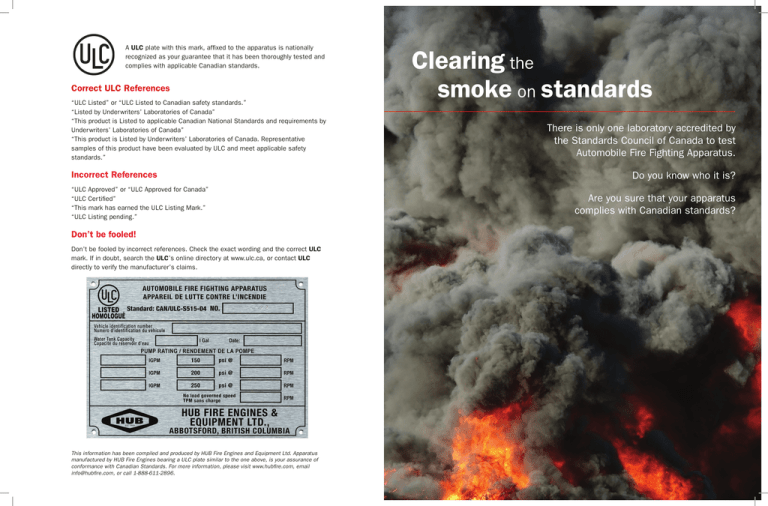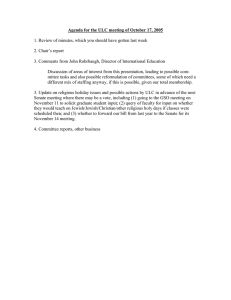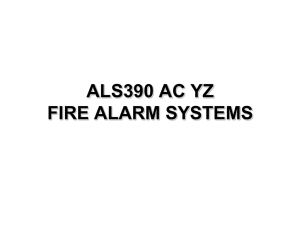Clearing The Smoke On Standards, 5.1MB
advertisement

A ULC plate with this mark, affixed to the apparatus is nationally recognized as your guarantee that it has been thoroughly tested and complies with applicable Canadian standards. Correct ULC References “ULC Listed” or “ULC Listed to Canadian safety standards.” “Listed by Underwriters’ Laboratories of Canada” “This product is Listed to applicable Canadian National Standards and requirements by Underwriters’ Laboratories of Canada” “This product is Listed by Underwriters’ Laboratories of Canada. Representative samples of this product have been evaluated by ULC and meet applicable safety standards.” Incorrect References “ULC Approved” or “ULC Approved for Canada” “ULC Certified” “This mark has earned the ULC Listing Mark.” “ULC Listing pending.” Don’t be fooled! Don’t be fooled by incorrect references. Check the exact wording and the correct ULC mark. If in doubt, search the ULC’s online directory at www.ulc.ca, or contact ULC directly to verify the manufacturer’s claims. This information has been compiled and produced by HUB Fire Engines and Equipment Ltd. Apparatus manufactured by HUB Fire Engines bearing a ULC plate similar to the one above, is your assurance of conformance with Canadian Standards. For more information, please visit www.hubfire.com, email info@hubfire.com, or call 1-888-611-2896. Clearing the smoke on standards There is only one laboratory accredited by the Standards Council of Canada to test Automobile Fire Fighting Apparatus. Do you know who it is? Are you sure that your apparatus complies with Canadian standards? Firefighting apparatus – is it certified to the right Canadian standard? by Jack Robertson A fire truck is one of the single largest capital investments a fire department will make. To protect that investment, purchasers should take every precaution to ensure they are not only getting value for their money, but also getting what they wanted in the first place. No matter what process is used, the piece of equipment that arrives at the fire hall should be exactly what was ordered. There are two ways to get that level of confidence: first, the equipment should be certified by an accredited certification organization; and second, the certification of the equipment should be in full conformance with the appropriate standard. Equipment “certified” by an accredited certification organization is not necessarily the same thing as equipment that “conforms to” or “meets” a certain standard. There is a difference. Being certified by an accredited product certification body communicates to prospective buyers that the supplier is committed to safety. It also shows that the manufacturer has met the requirements for per formance, safety and/or quality, as described by a nationally recognized standard. This process includes an audit of the facility and testing of the product. A product that meets the necessary criteria may be “listed,” and a description of the supplier, along with a list of products and services, is displayed on a certified product list. The online version of this list is accessible to all, including purchasers, government, corporations, retailers and the public. Even if equipment has been certified, purchasers still need to consider what organization certified it. Any company can say that a firefighting apparatus meets a standard, but is the company actually qualified to make this statement? If so, by whom? However, if that piece of firefighting apparatus is certified by an independent third-party organization accredited in Canada by the Standards Council of Canada (SCC), it has been done so by a qualified body. Why ULC? What about NFPA? How can this all be verified? Simple – a piece of firefighting apparatus that has been certified by Underwriters’ Laboratories of Canada (ULC) will have a label complete with a certification mark. Furthermore, the purchaser can always request a copy of the report from the manufacturer. Why is Underwriters’ Laboratories of Canada the authority on fire fighting apparatus? For all of these reasons, and more. ULC has published a completely revised standard for firefighting apparatus, CAN/ULC-S515, Automobile Fire Fighting Apparatus. This Standard defines the minimum per formance requirements for new automobile firefighting apparatus, such as pumpers, water tank trucks, ladder trucks and aerial devices used for structural firefighting in a municipal fire service. With input from key stakeholders, including manufacturers, fire authorities, insurance industry, regulators and the general public, the Standard reflects the needs of Canadian fire departments. It includes unique Canadian requirements, such as road per formance test requirements that specify balance and weight distribution, for the safety of both firefighters and the general public. A new requirement is that automatic or manual engine shutdown is no longer mandatory. This is left as an option for the purchaser. However, some local regulatory authorities and insurance groups may take steps to make this requirement mandatory. 2. ULC has tested products for public safety for more than 80 years. While the U.S. based National Fire Protection Association (NFPA) has and continues to make valuable contributions to the protection of society, the standards they recommend are based on a consensus of opinion, and not necessarily on sound research. In addition, this association “does not independently test, evaluate, or verify the accuracy of any information or the soundness of any judgments contained in its Codes and Standards.”* The preface of the Standard also recommends that firefighting apparatus “be certified by an independent third-party certification organization accredited by the Standards Council of Canada,” thereby reinforcing earlier statements. (originally published by Underwriters’ Laboratories, The Fire & Security Authority, Issue 1, 2006) 1. Underwriters’ Laboratories of Canada (ULC) is an independent, not-for-profit product safety testing and certification organization. 3. ULC is accredited by the Standards Council of Canada as a Certification Body, Testing Organization, Inspection Body and Standards Development Organization. 4. ULC is recognized by the American National Standards Institute and more than ten other organizations around the world for various aspects of their work. 5. ULC is the only laboratory accredited by Standards Council of Canada for the testing of Automobile Fire Fighting Apparatus. 6. The ULC certification means that a product, or system, has been evaluated, tested and complies with applicable Canadian standards. 7. As an independent and reputable third-party safety testing and certification organization, ULC provides a thorough and unbiased product evaluation. 8. Certification also means that manufacturers will receive on-going auditing through the ULC followup services program. 9. ULC is accredited by the Standards Council of Canada, under the National Standards System. 10. A CAN/ULC-S515-04 inspection is done in person by a representative of ULC and includes a review of construction methods, operator and passenger safety, electrical performance tests, road tests, pump performance, weight full and empty, and acceleration and braking tests. An apparatus must pass all tests at the factory before a ULC plate is issued. For more information about ULC visit www.ulc.ca. NFPA does not verify the methods by which apparatus are made by any particular manufacturer. They do not “list, certify, test or inspect products, designs, or installations for compliance with NFPA Codes and Standards.”* Any claims made by a manufacturer in regard to compliance with NFPA codes or standards are “solely the responsibility of the certifier or maker of the statement.”* As a result, the NFPA cannot attest to the quality of any product, device, or apparatus. In contrast, ULC standards are not set simply because they have been agreed upon by many different people, but are based on the findings of actual testing. Manufacturers cannot claim to be in compliance with ULC standards, but are subject to on-going audits. Before any apparatus receives a ULC plate, it is thoroughly and objectively inspected and evaluated in person by a representative of ULC. *NFPA Notice and Disclaimer from www.nfpa.org. ULC provides a thorough and unbiased product evaluation that guarantees the quality of materials, workmanship, and performance of every apparatus that receives their approval.


